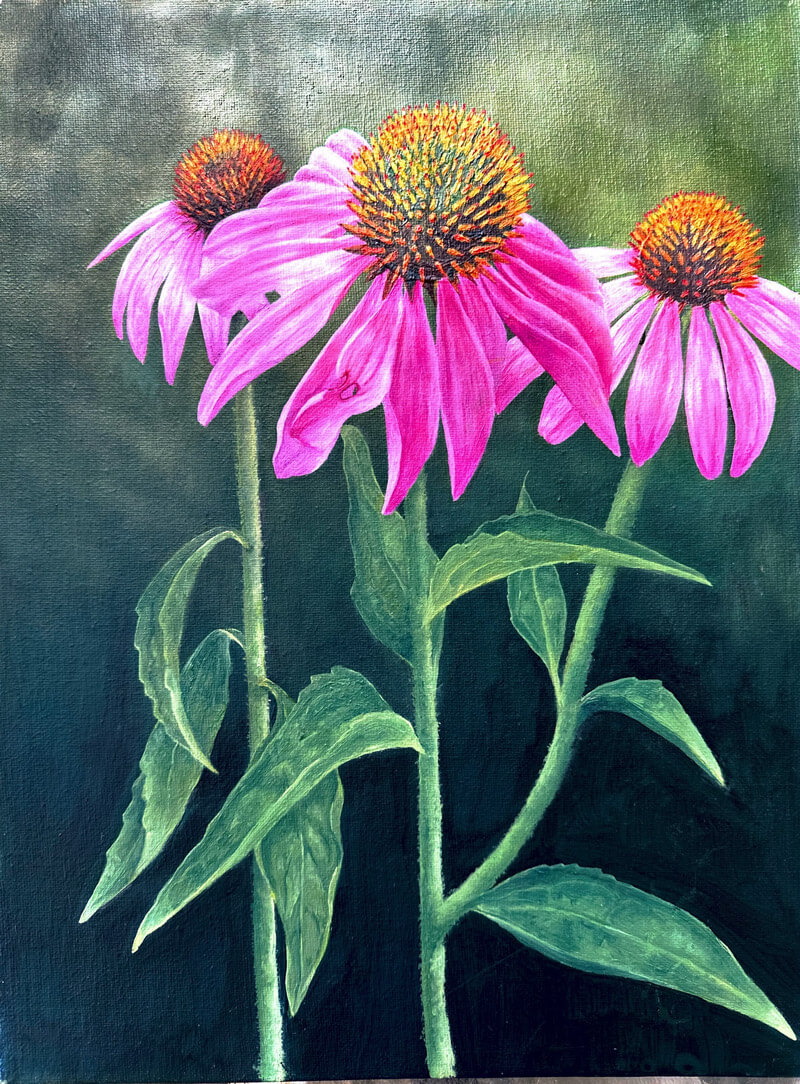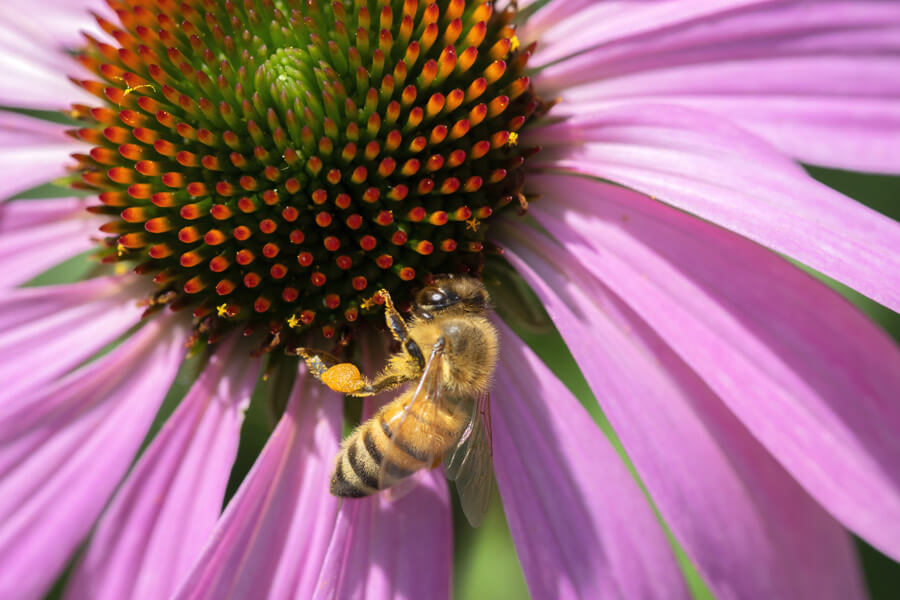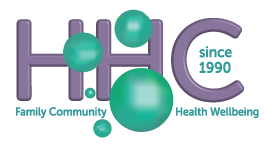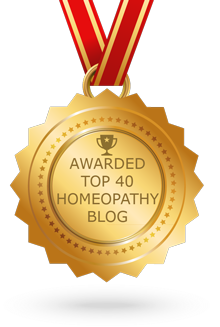I don’t have to try very hard to get to know the Echinacea plants in my garden. They’re urging me to connect with them so they can give away their healing story. They thrive off helping others. They yell loudly, “Come over here, I’ve got something to share with you.” There’s no holding back information in the world of Echinacea with such an unapologetic commanding voice; they’re definitely no fragile little daisy!
Having planted the Echinacea from seeds, it’s been fascinating to observe the many stages of growth, particularly the number of phases the flower traverses. The centre of the flower doesn’t actually start off in the cone shape it ends up as. It actually begins as a flatish centre with the petals radiating out horizontally. Gradually over many weeks, the petals stretch down towards the earth as the centre begins to morph into the cone shape it is named after coneflower. Looking at the flower up close, this is the first thing you notice – how the petals pull themselves down and out of the way to reveal the shiny seed head.
It looks something like the spines of a hedgehog according to American writers, especially since the name Echinacea comes from the Greek echinos, which means hedgehog. Apparently hedgehog quills really are spikey. But I live in Sydney so I’m not familiar with those little critters and anyway when I touch the Echinacea spikes on the seed head they’re not sharp at all. They bend when pressed, only to spring back to their shape once I stop pressing. In fact when Richard Katz observed this (and he already knew a lot about how Echinacea helps your immune system), he felt that Echinacea seedheads “are a living demonstration of resiliency in action, the way the immune system restores equilibrium when subject to stress”.
This hedgehog-ish centre of the flower is an in-your-face radioactive bright orange. It’s fair enough then if you start thinking of Echinacea as a herbal bomb once you’ve read about its super immune boosting powers, and how it was said to be useful for snakebites. But since when did Echinacea have a reputation of helping if a snake bites you? Apparently since forever if you study the history of herbal medicine. It was used for bacterial infection following a bite (snake, insect or animal). The indigenous people of North American used it for pain relief, rheumatism, and arthritis and as an antidote for poisons and venoms. They would put the mashed up root on to the wound like a poultice.
There are no hedgehogs where I live however and no rattlesnakes either. The Echinacea reputation, in Sydney 2023, is all about the flu, coughs, sore throats and post-viral fatigue. The great strength of the herb is in stimulating the lymphatic and immune systems.

“The Herbal Bomb” Echinacea plant oil painting by Belinda Elliott
Where and how does the plant grow?
The plant used to grow all over the prairies and woodlands of the eastern and central parts of America but sadly because it was so popular as a healing plant it has been over-harvested so much that it has now been placed on the “At risk” list.
In Australia, the plant is easy to grow. I have it coming up of its own accord in my garden these days from self-seeding. Honestly I don’t look after it that well. It’s a pretty tough perennial which is drought tolerant and goes dormant over winter. Sometimes it can get to be 1.5metres tall and will have flowers from early summer to late autumn. Depending on which variety you have, the flowers can be purple, pink or white. Breeders have recently introduced colours ranging from hot red, pale yellows and oranges, with variations of cone size and size of plants. If you want to use the plant for medicinal purposes you might as well choose to grow Echinacea purpurea or Echinacea angustifolia.
The cool thing is that lots of beneficial insects, bees, hoverflies and butterflies love the flower just as much as we do. There are often two bees loaded up with pollen on it at the same time.

Pollen laden bee on the spikes of the Echinacea cone seed head
You can grow it from seed but also after a few years you can divide the roots and give some to friends. The roots have the highest level of the therapeutic constituent and are used fresh or dried. Most Echinaceas have a long taproot and you can chop it into sections that are about 10cms long and give that away. However, Echinacea purpurea has fibrous roots in a clump which can also be divided.
What does the research say about this herbal bomb?
- Echinacea is rich in antioxidants like vitamin C, beta-carotene and flavonoids. Trace elements include. Zn, Fe, Ca, Mn and Se. It contains essential oils, inulin, and polysaccharides. It has antibacterial, antiviral, antifungal and larvicidal activities. Researchers believe that two chemicals in particular, polysaccharides and glycoproteins, boost your body’s immune system.
- There are a lot of studies about Echinacea and one of the best is a meta-analysis of RCTs which supports its use to reduce recurring respiratory tract infections.
- Echinacea as part of a dental mouth wash, works on gingivitis, dental plaque and may reduce microbial biofilm build up.
- There are bacteria which live inside Echinacea plants called endophytes. Their presence is considered useful for the plants. Research found that it’s the types and quantities of bacteria in the plants which determine just how much the herb will boost our immune system. How did they work this out? Echinacea purpurea plants sourced from different places were obtained: commercial growers; freshly harvested plants from greenhouses or plants growing wild. The most common bacteria they found in the plants was Proteobacteria, which is a powerful immune booster, a macrophage activator. Macrophages are a type of white blood cell that engulf and digest cancer cells, microbes, cellular debris, and foreign substances. For both fresh plant material and herbal extracts, the degree of macrophage activation was determined by both the amount and types of bacteria in the echinacea.
- The researchers noted that these findings could help explain why the results of clinical trials of Echinacea have been inconsistent. We now know that the amount of medicinal value of Echinacea depends on where and how the plants were grown since these conditions alter its associated bacterial community.
- Using Echinacea from plants containing a high bacterial load may have positive effects similar to taking probiotics.
How to make Echinacea tea
- There are a zillion versions of echinacea teabags and dried loose leaf tea using the root, flower and leaves. There are even more mixtures with other immune boosting herbs added.
- To make the tea from your own garden use the echinacea root, leaves and/or flowers.
- Place the dried or fresh leaves in a tea strainer in a cup. Add boiling water. Steep for 10-15 minutes. The longer the tea steeps, the stronger it will become.
- If you want to use the roots to extract medicinal properties from them, simply steeping the root in a tea strainer doesn’t make a potent Echinacea root tea. Instead you need to simmer the root in water for 15-20 minutes.
- You won’t start raving about how lovely it tastes, it’s more like a zing. That’s one good reason to add other herbs to make it taste a bit better.
- My favourite to add is lemon balm but calendula, ginger, lemon verbena and mint also go well.
- Here’s one example of quantities if you want to simmer a large amount and drink it through the day: One litre of water, a large handful of lemon balm leaves, a smaller number of echinacea petals and leaves and one sprig of rosemary. If you have dug up some echinacea root because you are coming down with a sore throat or have some early symptoms of the flu then add a tablespoon of root to your mix. Usually you will decide what to add by seeing whatever is available in the garden at the time. Don’t waste the root, boil it up again the next day until its lost it’s potency.
Some important hints about Echinacea the herb
It should cause a tingling sensation on the tongue, generating saliva. With larger doses, it is best to dilute it to avoid excessive salivation.
Use caution if you have a known allergy to anything in the Asteraceae family.
People start thinking it would be great to take echinacea as a herbal supplement regularly, hoping to prevent coughs and colds, especially respiratory viruses. However, traditional herbal medicine practitioners dictate that echinacea is best at the start of illnesses. But as a herbal tincture it’s just not something you can take every day. It does stimulate the immune system and although this is good in the short term, in the long-term, usually a couple of weeks or more, the overstimulation weakens the immune system.
So what should you do? When you start feeling a tickle in your throat, a runny nose, or any sign that you’re starting to get sick, start taking the recommended dose of echinacea as found on your supplement. But please don’t use Echinacea to prop up an immune system that is weakened when what is really needed are measures like rest, an improvement in diet, regular exercise and making an effort to regain a love of life. Tonic immune building herbs such as astragalus are more useful in this case. An actual consult with a herbal practitioner is even better.
Echinacea – the homeopathic remedy
Echinacea is in the Asteraceae plant family so it’s a daisy and it is the most widely cultivated plant in this species. Other remedies in the same daisy family include Arnica and Calendula, both great remedies for healing after trauma.
When used in a low potency such as 6x or 6c, the homeopathic remedy has much the same indications as the herbal medicine.
The homeopathic materia medica lists it for poisoned wounds, impetigo, acne and carbuncles. It is indicated for recurring boils, particularly small boils that are very sensitive, and come in crops, often on the neck and shoulders. But we mostly see that it is used for respiratory problems.
It is also well indicated for treatment of post viral fatigue and in this case its use is best guided by a homeopathic practitioner. Talking of chronic fatigue, Matthew Wood calls Echinacea the “farmer remedy because it is indicated for people who just can’t take a rest, have to work hard, through a season, and then fall sick when they do get a little break”. This also makes it a useful remedy for students who often get sick following exams or assessments, or for people who have poor work habits and no boundaries.
The person who would most benefit from the remedy would be feeling cranky, irritable, depressed and be someone who hates being contradicted. They might be prone to getting a dull headache and be unable to concentrate properly because their whole head feels dull. Their eyes ache when reading. “It tires me dreadfully to hold a book and read.” They speak slowly and definitely would feel worse after trying to make an effort and exert themselves, so having a rest would make them feel better.
In 1902, Dr John Henry Clarke also agreed that the person who will benefit from homeopathic Echinacea felt that “Drowsiness was a very marked feature” of their problem. Their symptoms were worse after eating; in the evening and after physical or mental exertion (studying). They felt better by lying down, and by rest. They were also chilly and sensitive to cold air.
The most interesting and little known way to use Homeopathic Echinacea is for HSC study fatigue and exhaustion after students have over-used their brain, and they find themselves in a space where they just can hardly think let alone study. This makes sense when we know that a well known use of the remedy is for chronic fatigue. It might be helpful in this transition time for teenagers who say they can’t “get their act together” and feel especially worse in the afternoon. Straight from the homeopathic proving comes the exhausted feeling of not being capable and “Can’t accomplish anything”.
If you have a first aid homeopathy kit you could add Echinacea 30c to it. When used for HSC study fatigue you could use Echinacea 30c three times a day for three days as a general rule of thumb. However, if the fatigue is of a more chronic nature then seeking a consult with a homeopathic practitioner is a wise decision given that there are many great fatigue remedies to differentiate it from.
Oil painting ‘The Herbal Bomb’
- Filling in the Gaps: A Homeopath’s Tour of a Dental Technician Lab - 08/11/2024
- Homeopathy surge worldwide - 11/08/2024
- Autism is helped by several different styles of homeopathy - 07/05/2024



